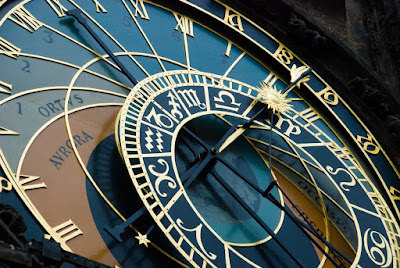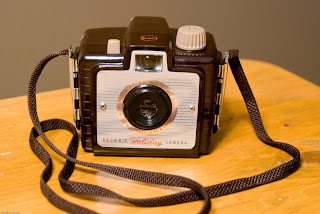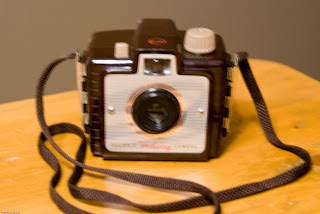
Astronomical Clock (1410) Prague, Czech Republic
 I just bought a new camera! It wasn't expensive, just 20 bucks on eBay, but to me it's a pretty special find. My new camera is exactly the same as my very first camera, the Kodak Brownie Holiday Camera, which I have referred to in earlier posts. It is pretty low-tech and doesn't have any settings, other than a winding knob and the shutter release. It consists of a brown bake-lite plastic light-proof box with a viewfinder and a shutter. I received my new camera in the mail today and was pleased to find that it is in almost mint condition.
I just bought a new camera! It wasn't expensive, just 20 bucks on eBay, but to me it's a pretty special find. My new camera is exactly the same as my very first camera, the Kodak Brownie Holiday Camera, which I have referred to in earlier posts. It is pretty low-tech and doesn't have any settings, other than a winding knob and the shutter release. It consists of a brown bake-lite plastic light-proof box with a viewfinder and a shutter. I received my new camera in the mail today and was pleased to find that it is in almost mint condition. As I was admiring my new (vintage) camera and thinking about how much cameras have changed in recent years, I thought that I would use my new camera to demonstrate the effectiveness of the vibration reduction (VR) technology found in many new lenses. Just as a point of interest, "VR" is a Nikon term while Canon uses the "IS" (Image Stabilization) designation for their comparable technology. When I first started researching the Nikkor 18-200 mm VR lens, I was skeptical of the claims that people were making about VR lenses. Nikon claims that photographers can shoot at a full two stops slower shutter speed than with a non-VR lens. A general rule of thumb for shutter speed is that the inverse of the shutter speed should be greater than the focal length of the lens that you are shooting with. What this means in practical terms is if you are shooting at 65 mm, you should be shooting at a minimum of 1/60 th of a second in order to minimize camera shake and blur. I am absolutely amazed at the actual results of this lens. The above photo was shot hand-held at 65 mm, ISO 400, f/5.0 at 1/3rd of a second.

This second photo was taken with exactly the same settings, but with the VR feature turned off. Click on each image to see a larger photo. I think the results of my demonstration clearly show the effectiveness of VR technology. The top image is not exactly "tack sharp" but it is usable. The second photo is definitely a reject.
Does VR make my tripod obsolete? Definitely not. But when I am travelling light and want to maximize mobility, VR is a credible alternative. When we were in Dublin and Dresden last summer, we saw signs in several of the old cathedrals stating that tripods were not even allowed inside. VR allowed me to capture several photos in dim light conditions that would otherwise not have been possible like image of the astronomical clock taken on a dark and drizzly day in Prague, Czech Republic last July.
As always, I appreciate and value your comments. I'd love to read your thoughts about VR or IS technology or your memories of your first camera.




No comments:
Post a Comment